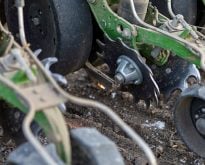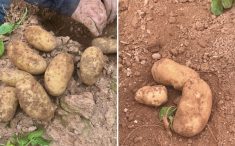If you want to know how bad weed resistance can get, ask the cotton farmers of Georgia about Palmer amaranth. From a single field in Macon County in 2005, glyphosate-resistant Palmer amaranth has exploded across the southern U.S. Cotton Belt.
A member of the pigweed family, Palmer amaranth has seriously affected weed management in cotton and other crops. Its resistance to glyphosate has forced some farmers to hoe Palmer amaranth by hand because the chemical intended to control it doesn’t work any more.
Travel north to the windswept Canadian Prairies and you’ll hear a story that starts to sound eerily familiar. This time the weed is kochia. In 2011, scientists first detected glyphosate-resistant kochia in southern Alberta — the first case of a glyphosate-resistant weed in Western Canada. Because it is a tumbleweed, kochia travels on the wind, scattering between 10,000 and 25,000 seeds per plant as it rolls along. Today, glyphosate-resistant kochia has been detected in parts of Saskatchewan and as far east as Manitoba.
Read Also

Producers aren’t panicking over tariffs and trade threats
The influence of tariff and trade uncertainity on farm business decisions.
It’s a long way from Georgia to southern Alberta but there’s still a straight line between the two. That line is herbicide resistance — a phenomenon resulting from the continuous use of herbicides with the same mode of action year after year.
There’s a growing realization that relying solely on one technique to control weeds gives the weeds a chance to adapt and become resistant. What’s needed is a system to keep weeds off balance by using a variety of control practices which makes resistance less likely.
In fact, there is such a system. It’s called integrated weed management. Now that herbicide resistance is on the rise, this system, called IWM for short, could be an idea whose time has come.
Although IWM has been around as a concept for some 30 years, it’s sometimes seen as nice but not very practical. However, that attitude may be changing as our overreliance on herbicides means cases of weed resistance continue to mount.
“Weed resistance is increasing all the time. That’s just a given. The more you use herbicides, the more resistance you will have,” says Bob Blackshaw, an Agriculture and Agri-Food Canada weed scientist in Lethbridge, Alta.
“Integrated weed management is probably the No. 1 way of delaying the onset of resistance and perhaps preventing it,” Blackshaw says. “It’s also probably the No. 1 thing you’re going to do if you have resistance on your farm. It’s managing existing weed resistance.”
Weed specialists cite three practices as the foundation of an IWM program: preventing weed problems before they start by limiting the introduction and spread of weeds; choking out weeds with crops that compete successfully against them; and keeping weeds off balance by making it difficult for them to adapt.
Joe Vink, weed management technical lead for Monsanto Canada, calls IWM a series of “many little hammers” to control weeds. Herbicides are only one of those hammers. “Integrated weed management is certainly not all about herbicides,” Vink says.
These “little hammers” include rotating herbicides, using multiple modes of action, incorporating tillage at strategic points in the rotation, diverse crop rotation, cover crops, increased seeding rates, narrow row spacing to shade out weeds, and optimum use of fertilizer.
Of these, crop rotation is probably the most critical in Blackshaw’s estimation.
“Crop rotation is the starting point for all pest management — weeds, diseases and insects. It’s probably the most important thing you can do,” Blackshaw says. “A weed may emerge at the same time as the crop, have a similar growth cycle and require the same growing conditions. If you grow that same crop over and over again, that weed is going to get larger in number and compete more effectively against the crop.”
Another hammer in the IWM toolbox involves controlling weeds through the timing of a specific crop. As an example, Blackshaw cites winter wheat. It is planted in summer, goes dormant in the fall and revives in the spring. So do winter annual weeds, such as downy brome and shepherd’s purse, which have the same life cycle. As a result, they compete successfully against winter wheat. To combat this, Blackshaw suggests switching to spring wheat, enabling producers to deal with emerging winter annual weeds before the spring wheat comes up.
Vink says producers see IWM as expensive and time consuming. But that’s not necessarily so. He says the test for IWM can be very simple, and growers may be practising it without even realizing it.
“If you have a diverse crop rotation and you are using at least two modes of action on every acre every year, you are practising a form of integrated weed management,” Vink says. “And if you’re just growing a wheat-canola rotation and using the same herbicides, you’re not practicing it.”
In a recent publication, Julia Leeson, an Agriculture and Agri-Food Canada weed biologist and Hugh Beckie, an AAFC weed scientist, list two major changes in Western Canadian farm management systems since the 1990s, namely zero-tillage and herbicide-resistant crops (especially canola). Farmers quickly saw the advantages of the new systems and adopted them rapidly. This changed their weed management strategies but significantly increased herbicide use. Leeson and Beckie say producers’ willingness to try new cropping techniques could now be channeled in a new direction, i.e. adopting IWM practices.
“Producers must be made aware of the potential of these practices not only to reduce pesticide use but also to delay resistance,” the two weed scientists wrote. “Further efforts must be made to convey the importance of diversifying operations in the face of the increasing development of herbicide-resistant weeds.”
That’s all well and good. But a criticism sometimes heard about IWM is that it’s not suited for big farms. Some say large farms require simple solutions and IWM is too complex to implement on extensive acreages.
Blackshaw doesn’t buy that argument. He believes IWM can actually work better on a big farm because you have more land for implementing a diversified crop rotation, whereas a smaller land base limits the number of crops you can grow.
Some crops use specialized equipment (e.g. corn and soybeans) which require a cash outlay that a small producer may not be able to afford but a larger one can. Adding new crops brings agronomic diversity to the rotation, so you’re not seeding the same field at the same time every year, thus selecting for weeds that thrive best in that kind of rotation.
Blackshaw recommends extending limited rotations (e.g. wheat and canola) to a longer ones which include pulse crops or forages. Alfalfa is a particularly good fit because the cutting means the weeds get chopped down before they can produce mature seed, thereby reducing the seedbank.
Other non-chemical methods of weed control include increased seeding rates and precision fertilizer placement. Blackshaw says seeding rates for cereal crops in Western Canada have doubled or even tripled in the last two decades — a good thing because more seeds produce a more competitive crop that chokes out weeds and pays for itself through higher yields. Banding fertilizer rather than broadcasting it places the nutrient close to the seed. This gives the emerging plant a jump on weeds, which usually germinate at the soil surface, not lower down where the fertilizer is.
When it comes to herbicides, a new hammer in the IWM toolbox is on the horizon. Seed companies are beginning to develop weed control technologies which include trait stacking. For example, Monsanto is developing next-generation, herbicide-tolerant crops to allow for multiple modes of action. Roundup Ready 2 Xtend soybeans, scheduled for release next year, will contain tolerance to both glyphosate and dicamba, a Group 4 herbicide mainly used in corn. Vink says the company plans to release the product across all soybean-growing regions of Canada in 2016.
















